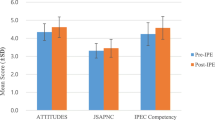Abstract
Background: Pediatricians, midwives and nurses are the health professionals who provide treatment and care to newborns in life-threatening clinical conditions. Their professional training also consists of the development of communicative and collaborative capacities. Interprofessional simulation is effective training for improving students’ collaborative attitudes, although many questions remain about its feasibility and acceptability. Study design and participants: with the aim of investigating if interprofessional high-fidelity patient simulation (IHFPS) increases interprofessional collaboration, we implemented a pre and posttest design study in a Northern Italian University. The sample was composed of 126 nursing students and 20 midwifery students attending the last year of Nursing and Midwifery programs respectively and 20 residents attending the last two years of the Pediatric Residency Program. Methods: participants, who were grouped into small interprofessional teams, participated in an experimental intervention based on an IHFPS. To measure interprofessional collaboration attitude, the Jefferson Scale of Attitudes toward Physician-Nurse Collaboration was administered to all participants in pre- and post-test of IHFPS. Results and conclusions: at the pre-test, nursing and midwifery students presented greater attitude of interprofessional collaboration than pediatric residents. At the post-test, only nursing students presented a statistically significant increase in their attitude of interprofessional collaboration, although midwifery students and pediatric residents also presented an improvement in interprofessional collaborative attitude. The results indicated that all three professional groups presented a more positive attitude toward collaboration following the interprofessional simulation event compared to the pre-training, suggesting that IHFPS is beneficial for increasing collaborative attitudes in different professional groups.
Access this chapter
Tax calculation will be finalised at checkout
Purchases are for personal use only
Similar content being viewed by others
References
Davies, N., Fletcher, S., Reeves, S.: Interprofessional education in maternity services: is there evidence to support policy? J. Interprof. Care 30(6), 812–815 (2016)
Berduzco-Torres, N., et al.: Factors related to the differential development of inter-professional collaboration abilities in medicine and nursing students. Front Psychol. 11, 432 (2020)
World Health Organization: Framework for action on interprofessional education and collaborative practice (2010). https://www.who.int/hrh/resources/framework_action/en/. Accessed 5 May 2021
Reeves, S., et al.: A BEME systematic review of the effects of interprofessional education: BEME Guide No. 39. Med. Teach. 38(7), 656–668 (2016)
World Health Organization: Transforming and scaling up health professionals’ education and training. World Health Organization Guidelines. World Health Organization, Geneve (2013)
Masotta, V., et al.: The concept of high-fidelity simulation and related factors in nursing education: a scoping review. In: Kubincová, Z., Lancia, L., Popescu, E., Nakayama, M., Scarano, V., Gil, A.B. (eds.) MIS4TEL 2020. AISC, vol. 1236, pp. 119–126. Springer, Cham (2021). https://doi.org/10.1007/978-3-030-52287-2_12
La Cerra, C., et al.: Effects of high-fidelity simulation based on life-threatening clinical condition scenarios on learning outcomes of undergraduate and postgraduate nursing students: a systematic review and meta-analysis. BMJ Open 9(2), e025306 (2019)
Rutherford-Hemming, T., Lioce, L.: State of interprofessional education in nursing: a systematic review. Nurse Educ. 43(1), 9–13 (2018)
Granheim, B.M., Shaw, J.M., Mansah, M.: The use of interprofessional learning and simulation in undergraduate nursing programs to address interprofessional communication and collaboration: an integrative review of the literature. Nurse Educ. Today 62, 118–127 (2018)
Johnston, S., Coyer, F.M., Nash, R.: Kirkpatrick’s evaluation of simulation and debriefing in health care education: a systematic review. J. Nurs. Educ. 57(7), 393–398 (2018)
Ward, J., Schaal, M., Sullivan, J., Bowen, M.E., Erdmann, J.B., Hojat, M.: The Jefferson scale of attitudes toward physician-nurse collaboration: a study with undergraduate nursing students. J. Interprof. Care 22(4), 375–386 (2008)
Tuirán-Gutiérrez, G.J., San-Martín, M., Delgado-Bolton, R., Bartolomé, B., Vivanco, L.: Improvement of inter-professional collaborative work abilities in mexican medical and nursing students: a Longitudinal Study. Front Psychol. 10, 5 (2019)
Hojat, M., et al.: Comparisons of American, Israeli, Italian and Mexican physicians and nurses on the total and factor scores of the Jefferson scale of attitudes toward physician-nurse collaborative relationships. Int. J. Nurs. Stud. 40(4), 427–435 (2003)
Ferri, P., et al.: The efficacy of interprofessional simulation in improving collaborative attitude between nursing students and residents in medicine. A study protocol for a randomised controlled trial. Acta Biomed. 89(7-S), 32–40 (2018)
Reese, C.E., Jeffries, P.R., Engum, S.A.: Learning together: using simulations to develop nursing and medical student collaboration. Nurs. Educ. Perspect. 31(1), 33–37 (2010)
Lockeman, K.S., et al.: The effect of an interprofessional simulation-based education program on perceptions and stereotypes of nursing and medical students: a quasi-experimental study. Nurse Educ. Today 58, 32–37 (2017)
McLelland, G., et al.: Interprofessional simulation of birth in a non-maternity setting for pre-professional students. Nurse Educ. Today 58, 25–31 (2017)
Ferri, P., et al.: Interprofessional high-fidelity simulation on nursing students’ collaborative attitudes: a quasi-experimental study using a mixed-methods approach. In: Kubincová, Z., Lancia, L., Popescu, E., Nakayama, M., Scarano, V., Gil, A.B. (eds.) MIS4TEL 2020. AISC, vol. 1236, pp. 99–110. Springer, Cham (2021). https://doi.org/10.1007/978-3-030-52287-2_10
Author information
Authors and Affiliations
Corresponding author
Editor information
Editors and Affiliations
Appendix
Appendix
Rights and permissions
Copyright information
© 2022 The Author(s), under exclusive license to Springer Nature Switzerland AG
About this paper
Cite this paper
Ferri, P. et al. (2022). The Collaboration Among Pediatric Residents, Nursing and Midwifery Students for Newborn Health: A Quasi-experimental Study on Interprofessional High-Fidelity Patient Simulation. In: De la Prieta, F., et al. Methodologies and Intelligent Systems for Technology Enhanced Learning, 11th International Conference. MIS4TEL 2021. Lecture Notes in Networks and Systems, vol 326. Springer, Cham. https://doi.org/10.1007/978-3-030-86618-1_20
Download citation
DOI: https://doi.org/10.1007/978-3-030-86618-1_20
Published:
Publisher Name: Springer, Cham
Print ISBN: 978-3-030-86617-4
Online ISBN: 978-3-030-86618-1
eBook Packages: Intelligent Technologies and RoboticsIntelligent Technologies and Robotics (R0)




